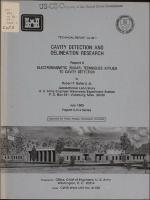Please use this identifier to cite or link to this item:
https://hdl.handle.net/11681/12804| Title: | Cavity detection and delineation research. Report 5, Electromagnetic (radar) techniques applied to cavity detection |
| Authors: | Ballard, Robert F. |
| Keywords: | Cavity detection Cavities (Underground) Karstic Crosshole Radar (ground probing) Electromagnetics Geophysical exploration Radar Seismic waves Medford Cave, Florida Manatee Springs, Florida |
| Publisher: | Geotechnical Laboratory (U.S.) Engineer Research and Development Center (U.S.) |
| Series/Report no.: | Technical report (U.S. Army Engineer Waterways Experiment Station) ; no. GL-83-1 rept. 5. |
| Description: | Technical Report Abstract: This study evaluated four different radar systems to determine their effectiveness in locating subterranean cavities. Tests were conducted at three well-documented sites: Vicksburg, Miss.; Medford Cave, Fla. (near Ocala); and Manatee Springs, Fla. (near Chiefland). None of the radar systems was effective at the Vicksburg, Miss., site because of extremely high conductivities encountered in the overburden materials which were comprised primarily of silts (loess) and clays. The following radar systems were used in this study : a.) A pulsed system fabricated and operated by personnel from Texas A&M University. b.) A pulsed system commercially manufactured by GSSI operated by the owners, Technos, Inc. c.) A pulsed system developed, fabricated, and operated by personnel from SwRI. d.) A continuous wave system developed, fabricated, and operated by personnel from LLNL. Tests were conducted at Vicksburg, Miss., using systems a, b, and c above. Systems b, c, and d were used at the Medford Cave, Fla., site; and systems c and d were used at the Manatee Springs, Fla., site. All of the systems were successful in locating cavities and other anomalous conditions at both Florida test siles. At the time these tests were conducted, only the SwRI system was capable of operating from the ground surface in the reflection mode and also in boreholes in crosshole fashion. (The GSSI system is currently available with borehole transmitter/receiver.) Air-filled cavities on the order of 3 to 4 ft in diameter were detected and confirmed to depths of more than 20 ft at the Medford Cave site both from the ground surface and by crosshole tests. A cavity zone approximately 6 ft in height was detected by crosshole tests at Manatee Springs. Radar signals were successfully propagated to distances exceeding 100 ft in the crosshole mode at the Medford Cave site. It was concluded that surface radar can be a very effective tool for locating subsurface anomalous conditions in limestones at sites where overburden materials are absent or have low dielectric and conductivity characteristics. Such sites would typically be comprised of low moisture content sandy materials. Use of surface radar at sites where the overburden is comprised mainly of clays will likely be ineffective. It was also concluded that crosshole radar was an effective tool for cavity detection (between boreholes) in limestone to borehole spacings of at least 30 ft. |
| Rights: | Approved for public release; distribution is unlimited. |
| URI: | http://hdl.handle.net/11681/12804 |
| Appears in Collections: | Technical Report |
Files in This Item:
| File | Description | Size | Format | |
|---|---|---|---|---|
| TR-GL-83-1-V5.pdf | 12.3 MB | Adobe PDF |  View/Open |